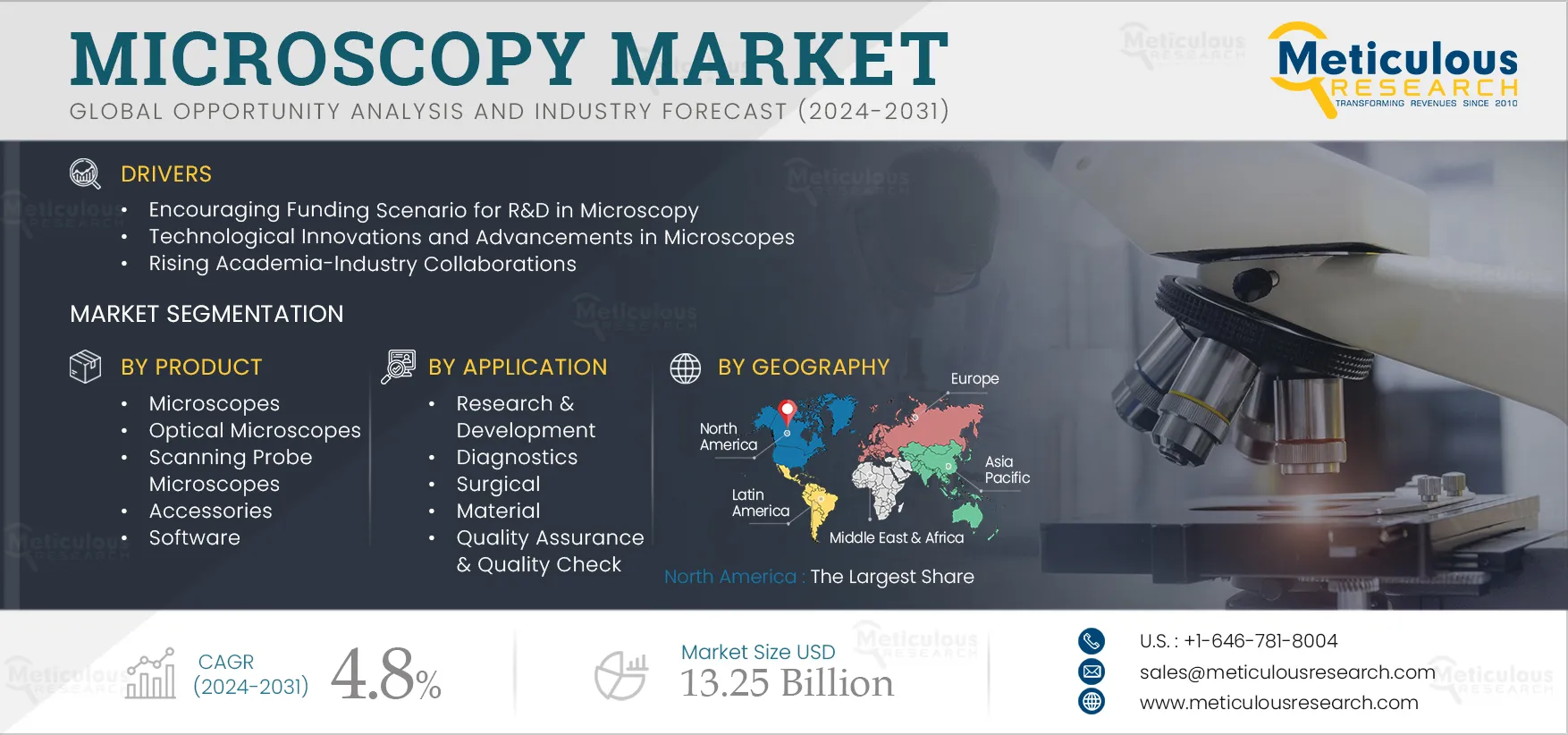Resources
About Us
Microscopy Market Size, Share, Forecast, & Trends Analysis by Product (Microscopes (Optical [Compound, Stereo, Digital] Electron [SEM, TEM] Scanning Probe [AFM, STM]), Software) Application (R&D, Material Analysis) End User – Global Forecast to 2031
Report ID: MRHC - 104251 Pages: 250 May-2024 Formats*: PDF Category: Healthcare Delivery: 24 to 48 Hours Download Free Sample ReportThe growth of this market is mainly attributed to the encouraging funding scenario for R&D in microscopy, technological innovations and advancements in microscopes, the increasing focus on regenerative medicine and nanotechnology, and rising academia-industry collaborations. Moreover, increasing demand for surgical microscopes and advancements in portable microscopy offer growth opportunities for players operating in the microscopy market.
Over the past few years, there has been a significant rise in funding to universities engaged in the R&D of microscopes. The funding has allowed universities or academic institutions to set up new facilities for developing high-tech microscopes to open up new, previously inaccessible research areas for scientists and researchers. Some of the recent funding granted to universities and academic institutions include:

Click here to: Get Free Sample Pages of this Report
Artificial Intelligence (AI) is used for image acquisition, processing, and analysis in microscopy. AI can help overcome the limitations of traditional microscopy tools. For instance, light-field microscopy and light-sheet microscopy have different challenges and advantages. To take advantage of the benefits of each technique, researchers at EMBL developed a machine-learning approach that uses light-sheet microscopy to train AI algorithms and light-field microscopy to image large 3D samples and then form an accurate 3D picture of the sample.
Microscopy generates a large number of images thus a large data set. AI can segment and recognize features in 2D and 3D images at a faster rate and more accurately than traditional image analysis. The researchers are still exploring the application of AI-integrated microscopy in quantum microscopy. As the quantity of data generated is increasing day by day, AI tools can be used to process the data which can be further used in various applications.
The integration of microscopy and spectroscopy combines the magnification capabilities of a microscope with the spectral analysis capabilities of a spectrophotometer, producing a powerful tool called a microspectroscope. These devices are useful in the study of traces and enable the understanding and interpretation of their structures. Microspectroscopes have several advantages, such as providing rapid and often non-destructive (or least destructive) analysis of a wide range of specimens, with little to no sample preparation, and the capability to create a reviewable record of the examination. The chemical analysis of traces using microspectroscopy enables forensic experts to determine the sample's origin along with its classification.
Recent advancements in this technology include the combination of atomic force microscopy (AFM) with IR and Raman spectrometers, which provide surface information (topography, hardness, adhesion, friction, and conductivity) and information on molecular chemistry with nanometer resolutions. This technique is ideal for the analysis of surface coatings and complex mixtures containing nanoparticles.
Surgical microscopes, commonly known as operating microscopes, are a type of optical microscope specifically designed to be used in surgical settings, allowing surgeons to access the most delicate areas, especially during microsurgeries. These microscopes have advanced features, such as stereoscopic vision of the surgical area, magnification, and illumination of image for the proper view of surgical sites used in neurosurgery, spine, oncology, ophthalmology, and other surgeries. In ophthalmic area, microscopes are used for glaucoma surgery, cataract surgery, retinal surgery, and other procedures.
Innovations in the field of fluorescence image-guided surgery (FIGS), the growing demand for minimally invasive surgery (MIS), and technological advancements in microscopy solutions are some of the other drivers for the growth microscopy for surgical applications. In the past few years, a considerable number of webinars related to FIGS have been conducted. These webinars further indicate advances in research and innovation in FIGS, which are expected to further boost the demand for FIGS, driving the use of microscopes in fluorescence image-guided surgical procedures.
Based on product, the microscopy market is segmented into microscopes, microscope accessories, and microscopy software. In 2024, the microscopes segment is estimated to account for the largest share of 71.5% of the microscopy market. The large share of this segment is mainly attributed to the technological advancements in microscopes and applications of microscopy in various fields. Also, the integration of microscopy with advanced technologies such as spectroscopy is further increasing its applications in many fields. Microscopy is ideal for the analysis of surface coatings and complex mixtures containing nanoparticles. Thus, the application areas and advancements in microscopy are contributing to the segment’s large share.
However, the microscopy software segment is projected to witness the highest growth rate of 9.0% during the forecast period of 2024–2031. Microscopy software is an essential part of microscopy that works with digital cameras and accessories, allowing digital image processing and sophisticated analysis in several diverse fields. The growth of this segment is mainly attributed to the wide applications of microscopy in various fields and technological advancements in microscopy software.
Based on application, the microscopy market is segmented into research & development, diagnostics, surgical applications, material analysis, and quality assurance & quality check. In 2024, the research & development segment is estimated to account for the largest share of 44.5% of the microscopy market. The large share of this segment is mainly attributed to the growing demand for research in structural biology, pathology, and plant biology, encouraging funding scenarios for R&D in microscopy, and growing demand for pharmaceutical products.
Based on end user, the microscopy market is segmented into industries, academic & research institutes, and other end users. In 2024, the industries segment is estimated to account for the largest share of the microscopy market. The large share of this segment is mainly attributed to the high demand for microscopes for qualitative and quantitative analysis in the semiconductor industry, the rising application of nanotechnology in various fields, and the increased utilization of microscopes in food testing laboratories. In food testing laboratories, microscopy is used to analyze a wide variety of food items and contaminants—from particles of food items and food fibers to pathogens and other contaminants.
In 2024, North America is expected to account for the largest share of the 39.2% of the microscopy market. The large share of the region is attributed to the encouraging funding scenario for R&D in microscopy, technological innovations & advancements in microscopes, increasing focus on regenerative medicine and nanotechnology, and rising academia-industry collaborations. The public and private players are providing grants for the use of microscopy techniques. For instance, in November 2022, the United States Department of Defense provided a grant of USD 599,503 to Florida Atlantic University (U.S.) to set up high-resolution imaging techniques that can reveal nanoscale structures.
However, Asia-Pacific is projected to witness the highest growth rate of 6.5% during the forecast period of 2024–2031. The region's growth is attributed to increasing attention to regenerative medicine, the growing electronics and life science industry, government initiatives to enhance food safety and significant growth in the pharmaceutical industry.
The report offers a competitive landscape based on an extensive assessment of the product offerings and geographic presence of leading market players and the key growth strategies adopted by them over the past few years. The key players operating in the microscopy market report include CARL ZEISS AG (Germany), Nikon Corporation (Japan), Bruker Corporation (U.S.), Olympus Corporation (Japan), JEOL Ltd. (Japan), Danaher Corporation (U.S.), Hitachi High-Tech Corporation (Japan), Thermo Fisher Scientific Inc. (U.S.), Oxford Instruments plc (U.K.), Accu-Scope Inc. (U.S.), Meiji Techno Co., Ltd. (Japan), and Labomed, Inc. (U.S.).
|
Particulars |
Details |
|
Number of Pages |
250 |
|
Format |
|
|
Forecast Period |
2024-2031 |
|
Base Year |
2023 |
|
CAGR |
4.8% |
|
Estimated Market Size (Value) |
$13.25 billion by 2031 |
|
Segments Covered |
By Product
By Application
By End User
|
|
Countries Covered |
North America (U.S. and Canada), Europe (Germany, France, U.K., Italy, Spain, Switzerland, and Rest of Europe), Asia-Pacific (China, Japan, India, South Korea, and Rest of Asia-Pacific), Latin America (Brazil, Mexico, Rest of Latin America), and Middle East & Africa |
|
Key Companies |
The key players operating in the microscopy market report include CARL ZEISS AG (Germany), Nikon Corporation (Japan), Bruker Corporation (U.S.), Olympus Corporation (Japan), JEOL Ltd. (Japan), Danaher Corporation (U.S.), Hitachi High-Tech Corporation (Japan), Thermo Fisher Scientific Inc. (U.S.), Oxford Instruments plc (U.K.), Accu-Scope Inc. (U.S.), Meiji Techno Co., Ltd. (Japan), and Labomed, Inc. (U.S.). |
The microscopy market covers the size & forecasts of the various microscopes used for research, diagnostics, surgical, material analysis, and quality assurance and quality check applications. This report studies the microscopy market by analyzing the value of various segments and sub-segments of microscope producers at regional and country levels.
The microscopy market is projected to reach $13.25 billion by 2031, at a CAGR of 4.8% during the forecast period.
Based on product, the microscopes segment accounted for the largest share of the microscopy market in 2024. The large share of this segment is mainly attributed to the technological advancements in microscopes and increasing applications of microscopy in various fields.
The industries segment is estimated to register the fastest CAGR during the forecast period due to the high demand for microscopes for qualitative and quantitative analysis in the semiconductor industry, growing pharmaceutical sales globally, the emergence of new pathogens, the rising prevalence of infectious diseases, and increased utilization of food testing laboratories.
Technological innovations and advancements in microscopes, encouraging funding scenarios for R&D in microscopy, growing attention towards regenerative medicine and nanotechnology, and increasing academia-industry collaborations are the key factors supporting the growth of this market. Further, significant opportunities for existing market players and new entrants include rising growth in emerging markets such as China and India and increasing applications of microscopy in various fields.
The key players operating in the microscopy market are CARL ZEISS AG (Germany), Nikon Corporation (Japan), Bruker Corporation (U.S.), Olympus Corporation (Japan), JEOL Ltd. (Japan), Danaher Corporation (U.S.), Hitachi High-Tech Corporation (Japan), Thermo Fisher Scientific Inc. (U.S.), Oxford Instruments plc (U.K.), Accu-Scope Inc. (U.S.), Meiji Techno Co., Ltd. (Japan), and Labomed, Inc. (U.S.).
Emerging economies like China and India are projected to offer significant growth opportunities for companies in this market. Increasing attention towards regenerative medicine, growing electronics & life science industry, government initiatives to enhance food safety, and significant growth in the pharmaceutical industry are the factors that will offer significant growth opportunities in this region.

























Published Date: Jan-2024
Published Date: Jun-2024
Published Date: May-2024
Published Date: Nov-2022
Published Date: Jun-2024
Please enter your corporate email id here to view sample report.
Subscribe to get the latest industry updates